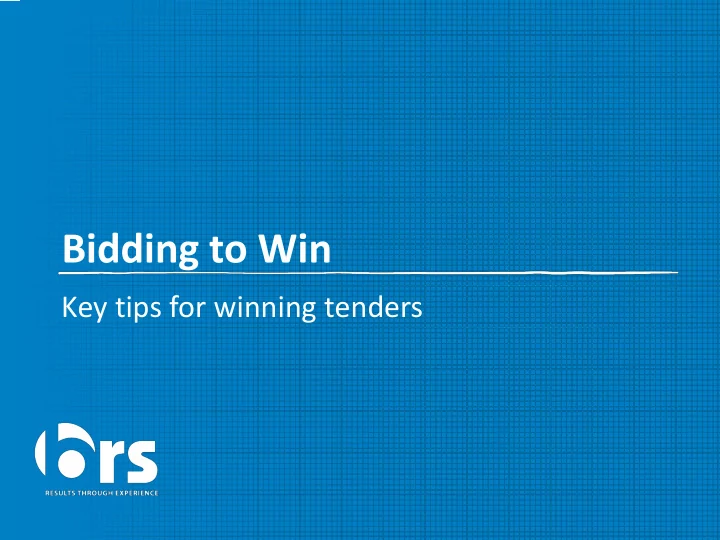

Bidding to Win Key tips for winning tenders
Introduction Topic for today - ‘bidding to win’ Format - tips, examples, stories and discussion
“A good written proposal might not, in itself, win you the business. But a badly conceived and badly written one may put you out of the race ” - Director of Procurement, Construction Sector
Bid approach AVERAGE BETTER BEST Focus: Articulate, Focus: ‘Get them Focus: a complete, compelling story something’ compliant document Identification and Done by anyone ‘Factory’ approach to alignment of bid team upfront responding to tenders No support Strategic approach – Reactive to RFT No strategy what are the client really looking for? What Chase everything Copy direct from are our differentiators? brochures or other Last minute Why should they pick us? documents Average output Proactive; planned Inconsistent output High quality output
Top 10 Tips Tips for giving yourself the best chance at winning bids
Be Selective Go or no go is the most important step in a bid process Don’t waste time and energy bidding for the wrong projects Focus efforts in the right areas When it comes to strategy and effort, what is more important than what you do is what you choose not to do
EXAMPLE: Go/ No-Go General Considerations
EXAMPLE: Go/ No-Go Decision Matrix
Upfront Effort If it is worth your effort to bid, it is worth your best shot Plan Bid Strategy Upfront alignment
Relationships require effort Each Opportunity/Project Effort into relationship Time
Ask Questions Don’t assume you know what the client wants Ask questions / clarify Try and understand the ‘why’ not just the ‘what’ Use the pre RFT or EOI stage to really understand what they are looking to achieve
Types of relationships Earning trust Trust Building relationships Giving advice freely Breadth of business issues Relationship Needs Service offering Depth of personal relationship
Overview of client Understand what the client really wants and needs and ASK QUESTIONS before the RFP or EOI is issued wherever possible
Tell a Story Make sure your bid conveys the right information Challenge: multiple authors Ensure story flows Answers real questions Why us?
Tell the client your story Outline: Issues Your strategies to resolve these issues Demonstrate your capability to carry out strategies Benefits to the client Establish a structured, flowing approach Be engaging and persuasive Rehearse, rehearse, rehearse!
What are the client’s issues? These are our key messages – need to ISSUE align W hat’s the strategy/the how – as to how we will solve/resolve this for them and deliver STRATEGY Where has the team done this before? And how does it EVIDENCE apply to this work? What is the benefit to the client? BENEFIT
The details matter Copy & Paste is not always your friend Make it specific / relevant to the job / client Conveys professionalism
Distinguish your promise to the client Choosing us will deliver world-class experience, demonstrated capability in the industry and a project team deeply committed to deliver a successful project within budget and schedule.
Distinguish your promise to the client What differentiates you from your competitors? An overall theme to your presentation One smooth sentence which sets you apart from your competition Tells the client the specific benefits that you promise to deliver on the project Amaze the client with your understanding of their project! Always quantify the benefits to the client
Think about the future Don’t just prepare to win the bid; prepare for how you will deliver the project Prepare yourself; set yourself up for success Put yourself in good standing for future work
Project Governance – Top Down and Bottom Up Top Down Role Clarity Client Objectives Project Charter – why, how & what Alignment/Foundation Workshops Project Team Values Project Objectives Project Reporting linked to KRA’s Project Governance Plan Key Result Areas KRA Plan / Framework linked to KPI’s High High Performance Plan Project Contract Performance Culture On time & On Quality & Safety & Knowledge & Stakeholders Team Health Budget Functionality Environment Innovation % % % % % % Governance Group/Advisory Board Expectations Direction Alignment Management Team Management Plans Project Management Plans Project Risk Reporting Project Team Bottom Up Technical Requirements Programme/Schedule Budget Deliverables/Milestones
Be prepared to deliver on what you promise If you’ve promised things before and not delivered it will be held against you Long term success depends on long term relationships Good delivery puts you in good stead for future work
Make Evaluation Easy Understand the evaluation criteria Make it hard for them to not shortlist you Understand the client’s objectives and drivers Answer the questions and link it back
Demonstrate your capabilities Highlight your capabilities to the client through past successful projects, client testimonials, financial information etc. Leverage the relationship with the client, and build on the client’s knowledge of the project manager and team Demonstrate you can solve key issues brought up by the client through your strategies for risk mitigation and removal
Align Everyone Involved Make sure everyone on the bid team is on the same page Prepare thoroughly for any client interactions Show that you are prepared and dedicated to this job and this client
Prepare for the client interactions What are the key elements? Purpose? Allocating time to what matters Who attends (why are they here?) What do they do in the presentation? How are you going to present? Talking and listening How are you going to handle questions?
Learn & Improve Learn from your mistakes Client debriefs – how can we do better? Internal learning Study – look at how other projects / organisations have achieved success
Lessons Learnt Workshop Agenda
Any questions? www.thebrsblog.com www.brsresults.com
Recommend
More recommend